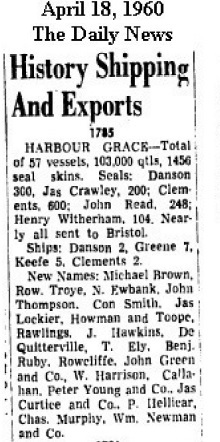Jersey Traders De Quetteville Freres & Guizot
Fishermen from the Channel Islands, especially Jersey, came to this village to fish every summer. It was historically a major fishing port. Around 1780, De Quetteville , a fishing company, made Blanc-Sablon their headquarters in the region for nearly a century. Their activities concentrated around cod fishing, and they went back home to Jersey each fall. In 1817, people came lo live permanently from Québec city, New Brunswick’s Acadie and Jersey Island
The fishing establishments were called “rooms,” and it is quite usual in this country to speak of them as “Jersey rooms,” no matter whether the proprietors belonged to Jersey or Guernsey. Harbour Grace is no doubt an Anglicization of Havre de Grace and was not named by the French, as they never resorted to Conception Bay either for fishing or for settlement, but it is a well-known fact that at a very early period two Jersey firms had fishing establishments there. The ground on which the Post Office stands and the land adjacent belonged to the Gushue family from time immemorial and was known as the “Jersey room.” Gushue is a corruption of Guizot, the name of a well-known Jersey family. As a proof that the Gushues were originally Guizots they can show a piece of plate with the name Guizot on it, which has been handed down for generations. Near the waterside of this property was a large rock in which an iron ringbolt was fastened, used in mooring ships, and on it were cut names and letters in old Jersey style. The De Quettevilles had an establishment on the south side of Harbour Grace, also known as the “Jersey room,” very early in the sixteenth century. The house on this property was called the Stone House and was built of freestone quarried at an island in the bay. Only the foundations now remain.
…..The Early Relations between Newfoundland and the Channel Islands, By: H.W. Le Messurier, C.M.G.
1750 “De Quetteville was trading from Harbour Grace between 1750 and 1790, being linked as time went on with Nicholas Fiott.” But the majority went out to Newfoundland at this period on a seasonal basis, and the merchants were engaged in the ‘sack’ trade, and carrving fish on the triangular route to New England, the West Indies and the Mediterranean together with miscellaneous goods collected for the outward journey or from ports of call as they returned to Jersey in the autumn.

These merchants, often younger sons of prominent families and intricately connected by marriage, pursued a pattern of trade already established by the French in the 16th. century.’ The prizes were high, but the risks were great and usually shared among a number of owners who were the bourgeois or outfitters, the armateurs or suppliers of equipment, the victualleurs and sometimes the maitre. A master might be his own armateur. Usually there were no wages, but agreed regulations about the sharing of profits, one third went to the owner, one third to the merchant and one third was to be divided among the crew. On arrival in Newfoundlandthe men set up temporary stations with wooden staging on which to split and dry the cod, the first captain to ….“Balleine’s History Of Jersey, page 170, DA670 J-5 B32, NEHGS



a cousin???




| From the Plantation Books 1804: “on the Southside of Harbour Grace the executors of John Clement claim 330 yards waterfront west from the stone house. The Noels and the Yetman’s still living there are also originally Jersey families and related to the Clements” (The stone house is the ruin of the DeQuetteville trading structure) |
| * The Yetman’s were from southern England. |
David de Quetteville (1683-1725) and his wife were actually the godparents of Clement’s older sibling (same name) who died.

An early De Quetteville ship owner?
